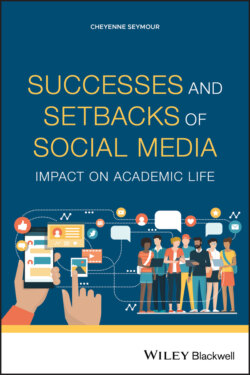Читать книгу Successes and Setbacks of Social Media - Группа авторов - Страница 12
Sharing Videos, Sharing Knowledge
ОглавлениеUsing multimedia in the classroom is a practice that has been in play for decades. Before the existence of the ever-popular video sharing platforms, educators infused multimedia into their lectures through projectors and television screens that rolled into lecture halls on four wheels (Rusk 2000; Berk 2009). Many faculty and students use platforms like Vimeo and YouTube to create and share content; these were introduced in 2004 and 2005, respectively (Grandoni 2013; Vimeo 2020). Although these social media sites are typically used differently by students and instructors, both groups benefit from usage.
Faculty often use video sharing sites to record the dissemination of information. An example of recording lessons can be found by examining Khan Academy, which provides customized educational plans through instructional videos “that empower learners to study at their own pace in and outside of the classroom” (Khan Academy 2020). Through the ease of creating media on video sharing platforms, faculty can independently record and share videos with their students in both on ground and online courses. Unlike a live lecture, students can continually reference videos for a refresher of the original content, if needed.
In addition, educators can share open-access videos, created by others, with students to aid in the clarity of course concepts. Using videos in the classroom can be beneficial for students (Berk 2009; Malouff and Shearer 2016). One study examined impressions of students regarding the use of videos in the class. “When asked if they find multimedia, such as YouTube, to be helpful for academic purposes, the majority (80%) reported that they did” (Fleck et al. 2014, pp. 29–30). The audiovisual element can provide visual examples, depict instructions, display artifacts, and more. “Textbooks and teaching materials can lack the diversity that is present in the student population and/or the society in which our students will interact” (Fleck et al. 2014). However, instructors can compensate for this limited diversity by supplementing course materials with multimedia that is reflective of the campus and regional population.
Just as many students use pen and paper or laptops and printers to complete collegiate assignments, they can use mobile devices and video sharing platforms to capture and deliver oral presentations. With the growing trend of using virtual presentations and videoconferences in higher education and the workplace, students are developing critical communication skills (Marlow et al. 2017; Al-Samarraie 2019). Researchers have found there are advantages when students use YouTube as the vehicle to deliver oral presentations, which include convenience for large and online classes, effective use of class time, and the ability of students to examine their individual performance; furthermore, students who utilized YouTube to present their oral assignment acknowledged an increase of skill, confidence, and knowledge after the presentation (Malouff and Emmerton 2014). Video sharing platforms give students control over their content; they can revise and edit their final product just as they would be able to do if they were writing an essay for a composition course – all while simultaneously gaining the experience of fine-tuning their oral communication skills.
